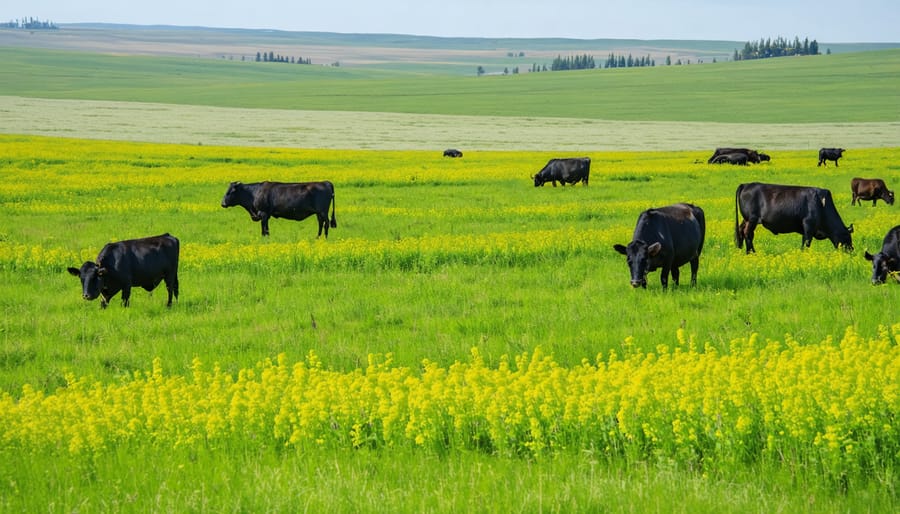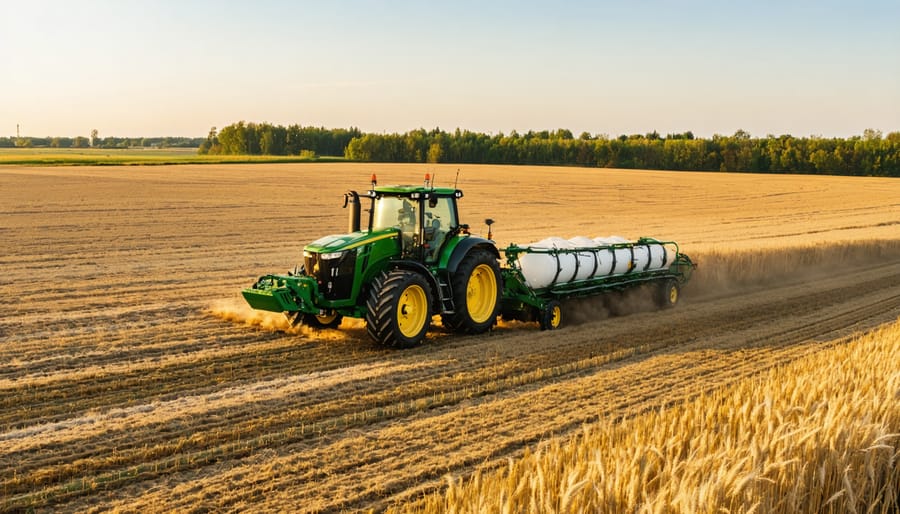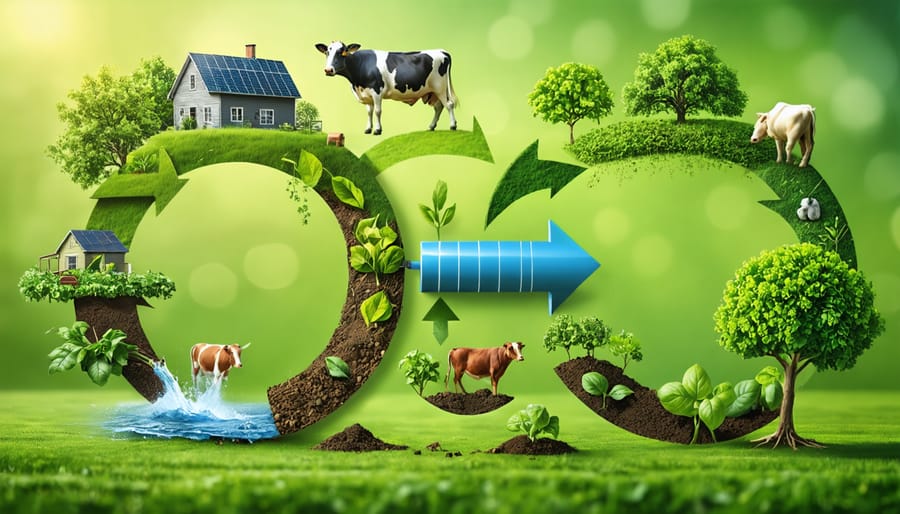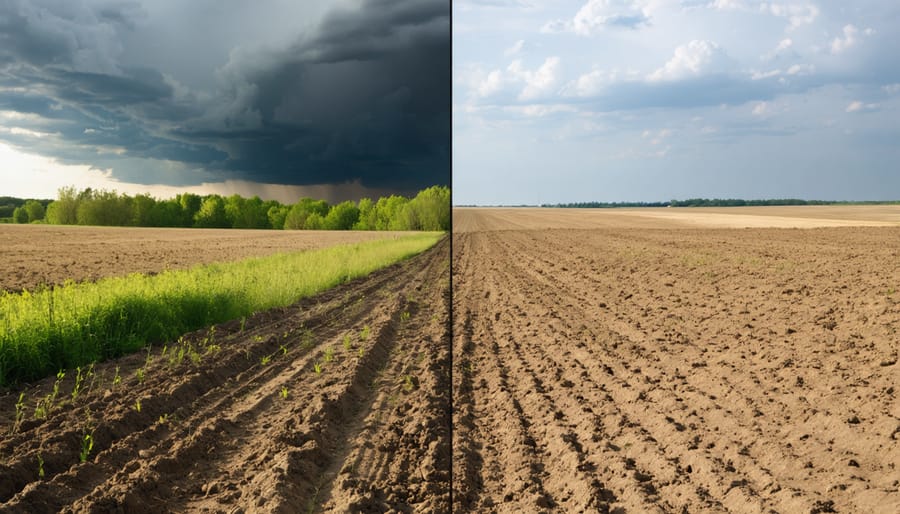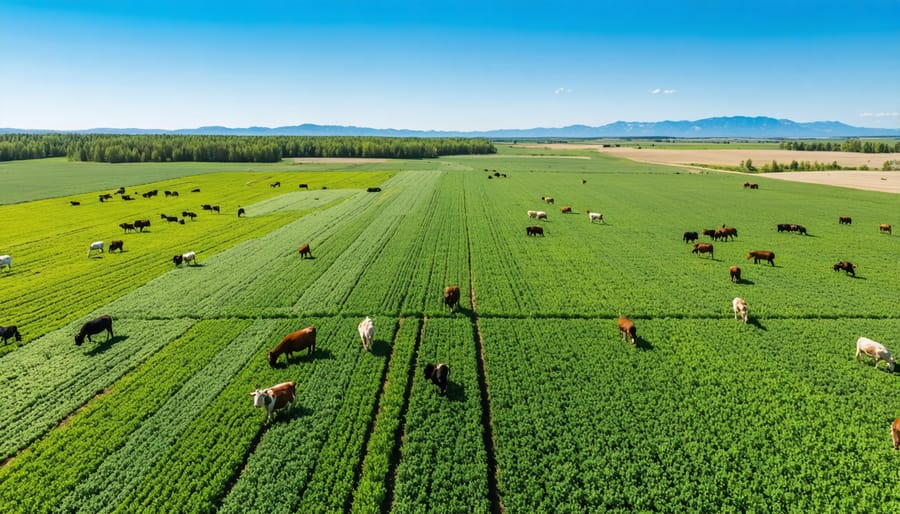Across Alberta’s diverse agricultural landscape, regenerative farming isn’t just sustaining the land—it’s revolutionizing how we think about agricultural productivity. From the rich black soils of the Peace Country to the prairie grasslands, Canadian farmers are discovering that regenerative practices deliver both environmental resilience and economic stability. Recent data from the University of Alberta shows that farms implementing regenerative methods have reduced input costs by 35% while increasing soil organic matter by 2% over five years. These results challenge the notion that sustainable farming requires sacrificing profitability.
Local success stories, like the Henderson Family Farm in Red Deer County, demonstrate how cover cropping, rotational grazing, and minimal tillage have transformed depleted fields into thriving ecosystems that produce consistent yields even during drought years. Their soil water retention has improved by 40%, significantly reducing irrigation needs and operating costs.
As climate challenges intensify and input costs rise, regenerative farming offers a practical path forward that enhances both land stewardship and farm viability. The question isn’t whether regenerative farming is sustainable—the evidence shows it’s becoming essential for the future of Canadian agriculture.
The Real Impact of Regenerative Practices on Soil Health
Measuring Success in Alberta’s Fields
Alberta farmers implementing soil regeneration techniques are seeing measurable improvements in their soil health and crop yields. Recent studies conducted by the University of Alberta’s Agricultural Research Station show promising results across multiple test sites in the province.
In Lacombe County, third-generation farmer Jim Peterson documented a 32% increase in soil organic matter over five years after transitioning to regenerative practices. His soil tests revealed improved water retention capacity and higher nutrient density, leading to a 15% reduction in irrigation needs.
The Morrison Family Farm near Red Deer presents another success story, where comprehensive soil testing showed a significant increase in beneficial microorganisms and earthworm populations. Their implementation of cover cropping and rotational grazing resulted in topsoil depth increasing by 4 centimetres over three years.
Soil samples from 15 regenerative farms across central Alberta demonstrated average increases of:
– 40% higher carbon sequestration rates
– 25% improved water infiltration
– 35% increase in soil biodiversity
– 20% reduction in synthetic input requirements
These results align with provincial sustainability goals while providing tangible evidence that regenerative farming practices can create resilient agricultural systems. Local agricultural extension offices now use these case studies to help other farmers transition to regenerative methods, showing that success is both achievable and measurable in Alberta’s unique growing conditions.
Beyond Organic: The Regenerative Advantage
When comparing regenerative and conventional farming methods, the data consistently shows that regenerative practices offer significant advantages across multiple metrics. Studies examining Canadian farms have demonstrated the proven benefits of agroecological practices, particularly in soil health and biodiversity.
Alberta farmers implementing regenerative methods report up to 60% higher organic matter content in their soil compared to conventional counterparts. This increased soil health translates to better water retention, with regenerative farms requiring 30% less irrigation on average. These farms also demonstrate greater resilience during extreme weather events, a crucial advantage in our changing climate.
Beyond environmental benefits, regenerative farms show impressive economic outcomes. Local case studies indicate that while initial transitions may require investment, regenerative farms typically reduce input costs by 40% within three years. These savings come from decreased reliance on synthetic fertilizers and pesticides, alongside lower machinery and fuel expenses.
Biodiversity measurements on regenerative farms show an average increase of 75% in beneficial insect populations and 50% more bird species compared to conventional operations. This natural ecosystem support helps control pests and promotes pollination, creating a self-sustaining agricultural system that reduces the need for external inputs while maintaining or improving yields.
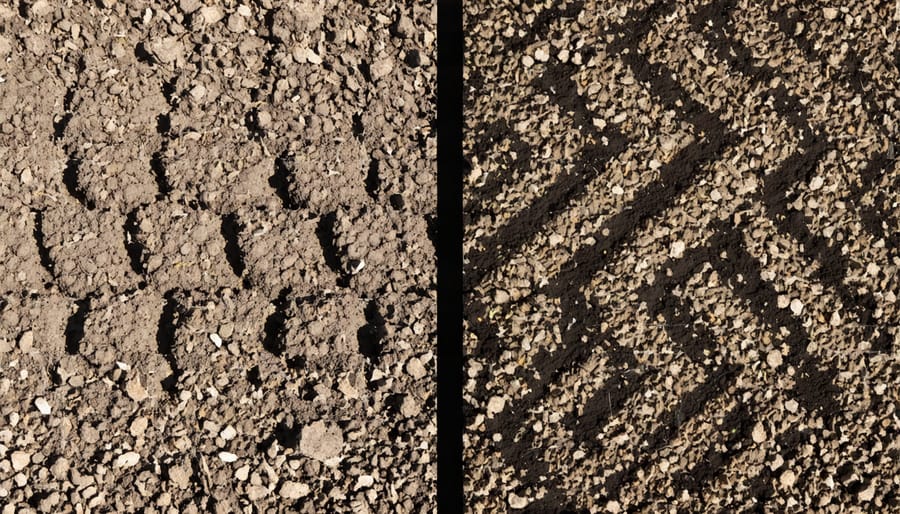
Economic Viability: The Bottom Line
Initial Investment vs. Long-term Returns
The financial realities of transitioning to regenerative farming show a clear pattern: while initial costs can be significant, the long-term returns often justify the investment. According to a recent study of Alberta farms, the average initial investment ranges from $600 to $1,200 per hectare, covering costs like soil testing, new equipment, and cover crop seeds.
Let’s look at the numbers from Prairie Ridge Farms, a 400-hectare operation near Red Deer. In their first year of transition, they invested $285,000 in new equipment and soil amendments. However, by year three, they reported a 35% reduction in input costs, primarily from decreased fertilizer and pesticide use. Their soil organic matter increased from 2.3% to 4.1%, improving water retention and reducing irrigation needs by 40%.
The Davidson Family Farm in southern Alberta presents another compelling case. Their initial $175,000 investment in regenerative practices was recovered within four years through reduced operational costs and improved crop resilience. During the 2021 drought, their yields remained 25% above regional averages, demonstrating the system’s resilience.
Key financial benefits typically emerge in this timeline:
– Years 1-2: Higher costs, learning curve
– Years 3-4: Break-even point, reduced input costs
– Years 5+: Improved profitability, soil health dividends
Local agricultural credit unions now offer specific financing options for regenerative transitions, recognizing the proven return on investment. Many farmers report additional revenue streams through carbon credits and premium pricing for regeneratively grown products, further strengthening the business case for this sustainable approach.
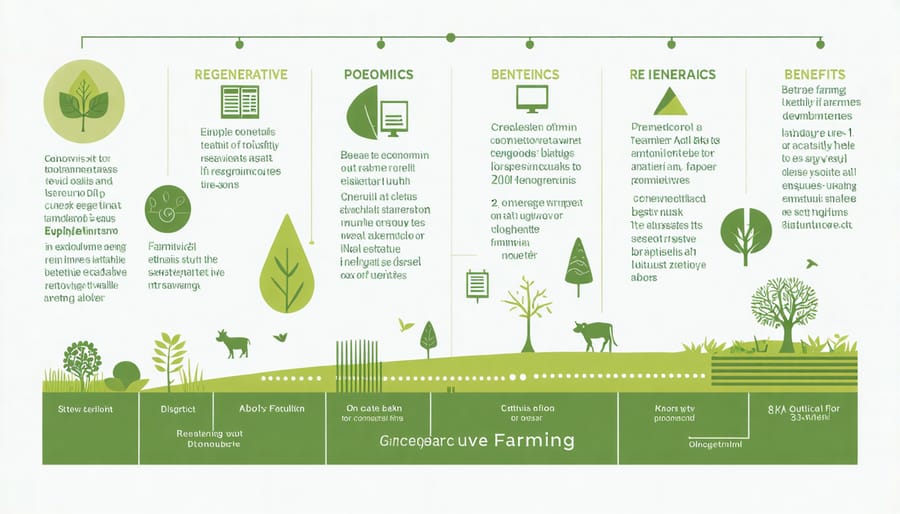
Market Opportunities for Regenerative Crops
The market for regeneratively grown crops continues to expand across Canada, offering promising opportunities for Alberta farmers. Major food companies like General Mills and Cascadian Farm are actively seeking partnerships with regenerative farmers, often offering premium prices that are 10-25% higher than conventional market rates.
Local success stories include the Prairie Farm Collective, where farmers are receiving an average of $14.50 per bushel for regeneratively grown wheat compared to the standard $11.75 market price. These premium prices help offset initial transition costs while providing long-term financial stability.
Consumer demand for sustainably produced food is also rising steadily. Recent market research shows that 73% of Canadian consumers are willing to pay more for products grown using regenerative practices, particularly when they can trace the source to local farms.
Several certification programs now recognize regenerative practices, creating additional market opportunities. The Regenerative Organic Certification (ROC) and Canadian Organic Regime (COR) help farmers access premium markets and build consumer trust. Local food co-ops and direct-to-consumer programs in Alberta are also creating reliable sales channels for regenerative farmers.
For those considering the transition, emerging carbon credit markets present another revenue stream. Alberta farmers practicing regenerative methods can earn additional income through carbon sequestration credits, with some early adopters reporting earnings of $30-45 per hectare annually through these programs.
Environmental Sustainability Metrics
Carbon Sequestration Results
Recent soil carbon measurements from Alberta farms implementing regenerative practices have shown promising results. Data collected from 15 farms across central and southern Alberta between 2019-2022 revealed an average increase in soil organic carbon of 0.8% per year, significantly higher than conventional farming methods.
The Morrison Family Farm in Lacombe County, for instance, documented a 2.3% increase in soil organic carbon over three years after transitioning to regenerative practices, including no-till farming and cover cropping. Their success has been attributed to maintaining living roots in the soil year-round and minimizing soil disturbance.
Similarly, a collective study of five farms in the Peace Region demonstrated that implementing planned grazing and diverse crop rotations led to carbon sequestration rates of 2.5 to 3.8 tonnes per hectare annually. These farms also reported improved water retention, with soil moisture levels increasing by 30% compared to neighboring conventional operations.
The data suggests that Alberta farms using regenerative practices can sequester an average of 3.1 tonnes of carbon per hectare annually, while simultaneously improving soil structure and fertility. These results are particularly significant for our province’s agricultural sector, as they demonstrate the potential for farms to contribute to climate change mitigation while enhancing their land’s productivity and resilience.
Water Conservation Success Stories
Alberta farmers are leading the way with innovative water management strategies that demonstrate the remarkable potential of regenerative farming. The Morgan Family Farm in Lacombe County reduced their irrigation needs by 40% after implementing cover crops and no-till practices for just three years. Their soil’s improved water retention capacity has helped them maintain crop yields even during recent dry seasons.
In Southern Alberta, the Peterson Heritage Farm showcases how strategic composting and diverse crop rotation transformed their previously water-dependent operation. Their soil now holds up to 30% more moisture compared to conventional farming methods, resulting in significant water savings during the critical growing season.
The Meadowbrook Collective, a group of five farms near Red Deer, documented a 45% reduction in water usage through combined regenerative practices. Their success stems from implementing contour farming, establishing windbreaks, and maintaining year-round soil coverage. These practices not only conserved water but also reduced erosion and improved overall soil health.
These real-world examples highlight how regenerative farming practices create a positive feedback loop: better soil structure leads to improved water retention, which supports healthier crops and requires less irrigation, ultimately building more resilient farming operations across Alberta’s diverse agricultural landscape.
Practical Implementation Strategies
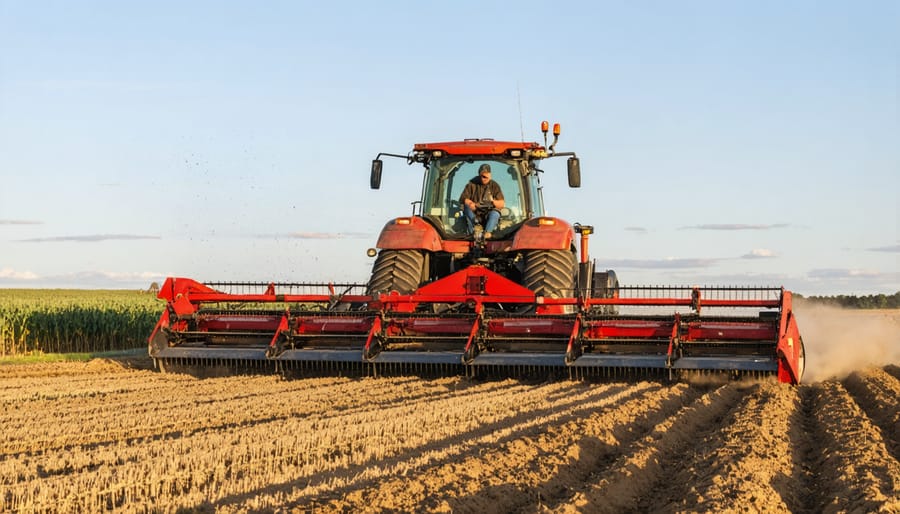
Starting Small: First Steps for Alberta Farmers
Starting your regenerative farming journey doesn’t require an immediate overhaul of your entire operation. Begin with a small test plot of 1-2 hectares to experiment and learn. Many successful Alberta farmers recommend starting with these foundational practices:
First, implement no-till or minimal tillage methods on your test plot. This helps preserve soil structure and organic matter while reducing erosion. Consider investing in soil monitoring technologies to track improvements.
Next, introduce cover crops suitable for Alberta’s climate, such as fall rye or field peas. These crops protect soil during harsh prairie winters and add valuable nutrients. Start with simple single-species covers before moving to diverse mixes.
Establish rotational grazing on a small scale if you have livestock. Even a few paddocks can demonstrate the benefits of planned grazing. Use temporary electric fencing to test different configurations without major infrastructure investments.
Focus on enhancing soil biology by minimizing synthetic inputs on your test plot. Consider applying compost or compost tea to introduce beneficial microorganisms. Document your observations, soil test results, and yield data to track progress and make informed decisions about scaling up these practices.
Scaling Up: Lessons from Successful Transitions
Successful regenerative farmers across Alberta emphasize the importance of starting small and scaling gradually. Tom Anderson, a third-generation farmer from Red Deer County, shares, “We began with just 40 hectares, testing different cover crop combinations before expanding to our full 400 hectares. This approach helped us minimize risks and learn from our mistakes.”
Key transition strategies from experienced practitioners include implementing changes in phases, typically over 3-5 years. Many recommend beginning with soil testing and introducing cover crops on a small portion of land while maintaining conventional practices elsewhere. This allows for direct comparison and adjustment of methods.
Sarah McLean, who runs a 280-hectare mixed farm near Lethbridge, suggests networking with other regenerative farmers: “Join local farming groups and attend field days. The community knowledge here in Alberta is invaluable.” She emphasizes the importance of documenting changes through photographs and soil tests to track progress.
Financial planning is crucial during the transition. Successful farmers often maintain a financial buffer for the first two years while soil health improves and new systems establish. Many report accessing transition support through Canadian Agricultural Partnership programs and working closely with agricultural extension services for technical guidance.
The evidence strongly supports regenerative farming as a sustainable agricultural approach, particularly within the Canadian context. Through documented success stories across Alberta’s diverse landscapes, we’ve seen how these practices not only maintain but actively improve soil health, water retention, and biodiversity while providing stable economic returns for farmers.
Research from local agricultural stations shows that farms implementing regenerative practices have experienced up to 40% increase in soil organic matter over five years, while reducing input costs by 25-30%. These improvements translate to greater resilience against climate extremes and more predictable yields, addressing both environmental and economic sustainability concerns.
Looking ahead, the future of regenerative farming in Canada appears promising. Growing consumer demand for sustainably produced food, combined with increasing government support through carbon offset programs and sustainability initiatives, creates a favorable environment for farmers transitioning to regenerative methods. Industry partnerships and mentor networks are expanding, making knowledge and resources more accessible to those interested in adoption.
While challenges remain, particularly during the transition period, the mounting evidence suggests that regenerative farming offers a viable path forward. As more Canadian farmers embrace these practices and share their experiences, we’re building a stronger foundation for sustainable agriculture that benefits both our farming communities and the environment. The key to success lies in our continued commitment to learning, adapting, and supporting one another as we work toward a more resilient agricultural future.

